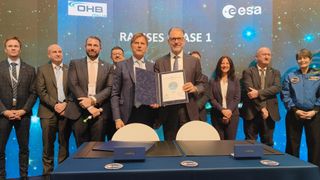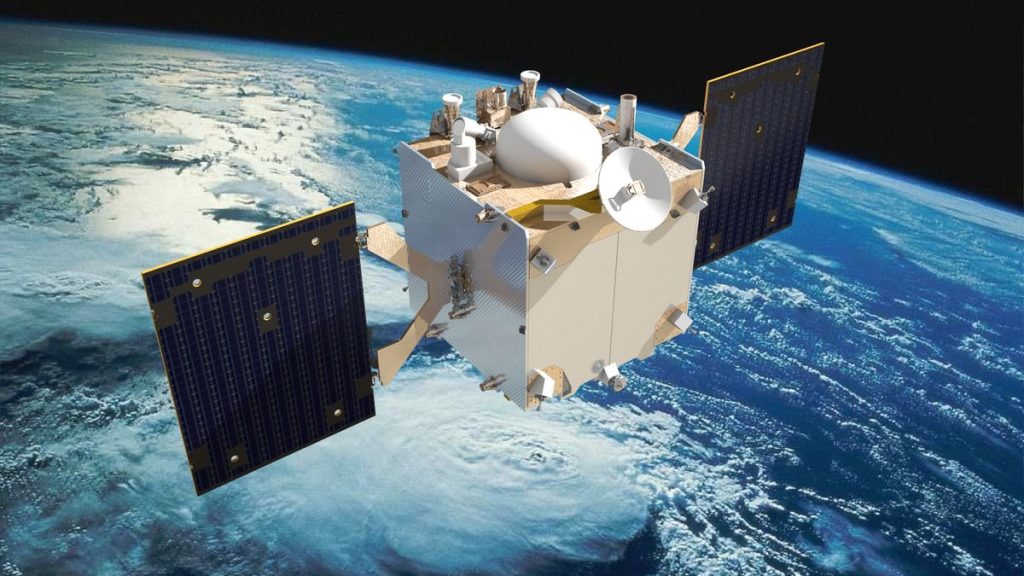MILAN — The European Space Agency (ESA) has taken the first big steps toward rendezvousing with an asteroid due to make a close approach to Earth in 2029.
ESA signed a contract worth €63 million (about $68 million US at current exchange rates) with OHB Italia at the International Astronautical Congress (IAC) here on Thursday (Oct. 17), allowing teams to proceed with phase 1 of mission development.
The Rapid Apophis Mission for Space Safety mission, or Ramses for short, faces a race against time. It needs to launch in early 2028 in order to get up close with the infamous asteroid Apophis as it passes Earth on April 13, 2029. The planetary defense mission would study Apophis’ composition, structure and how the tidal forces of Earth affect the asteroid and its cohesion.
The mission is not completely approved and funded: ESA member states will need to dish up the full requirement of money for Ramses at the agency’s next crucial Ministerial Council meeting in 2025. But Thursday’s signing means that the mission can hit the ground running in case of a potential positive decision, by already getting to work on time-critical activities, including finalizing the overall design.
Related: Apophis: The infamous asteroid we thought might hit us
Ramses has the recently launched Hera mission to thank for its chance to race to meet Apophis. The spacecraft will be an adapted version of Hera, carrying a suite of instruments. And the phase 1 development is being paid for by money saved by Hera being completed under budget.
“To be there on time is very challenging. We could not wait for the Ministerial; therefore, with exceptional circumstances, we asked our member states to make use of available resources,” said Paolo Martino, ESA Ramses project manager.
The mission, however, presents an opportunity to study a unique and timely event, as the 1,230-foot-wide (375 meters) Apophis is due to make an exceptionally close pass to Earth in 2029. The asteroid will move inside geostationary orbit and be visible to the naked eye.
“This is not only a fascinating mission for us; it’s also a major milestone of our planet and defense activities,” said Holger Krag, ESA’s Space Safety Program head. “Our goal in the space safety program is to provide warnings of three weeks’ time to notice for all objects of 30-meter [100 feet] size and larger, and to deflect asteroids up to 500-meter [1,650 feet] size, and Apophis is exactly in this size.”
Roberto Aceti, managing director at OHB Italia, says the mission will require a different approach, emphasizing the need for fast and efficient project management to meet the tight timeline.
“There will be a different way to deal with mission risks, because, at the end of the day, the ability to steer the mission development is directly connected to the way you manage risks. And the risk here is delays. If we miss by one week, the asteroid is gone,” Aceti said.

ESA Director General Josef Aschbacher and others praised the rapid decision-making and support from member states, which allowed the pragmatic actions and the potential fast development of the Ramses mission.
ESA astronaut Samantha Cristoforetti also voiced support for the mission. “Ramses is an incredible step in progressing in our ability as humanity to take care of ourselves and protect our homeworld,” Cristoforetti said.
Ramses won’t be the only mission potentially visiting Apophis. NASA’s OSIRIS-REx spacecraft, which collected samples from the asteroid Bennu and delivered them to Earth, is on an extended mission — named OSIRIS-APEX — and will arrive at Apophis roughly one month after the asteroid’s Earth flyby.
OSIRIS-REx and Ramses, like Hera and NASA’s Double Asteroid Redirection Test (DART), could be another example of space agencies coming together to develop planetary defense capabilities.

